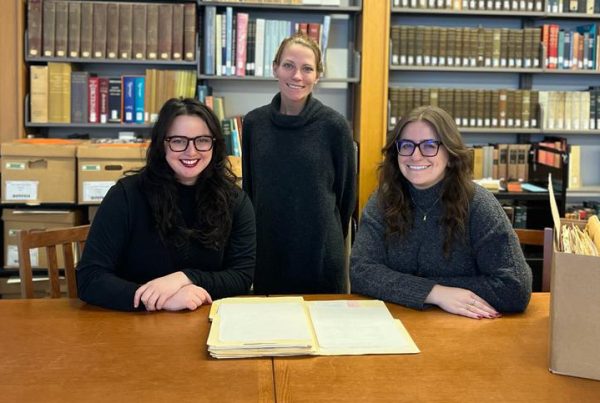Spotlight on Research: Our guest author Nina Bogdan was awarded the Immigration History Research Center Archives (IHRCA) Grant-in-Aid Award this year, and visited us for five days to explore the material in the IHRCA. This blog post explains Bogdan’s research project and how these sources relate to it. Bogdan is a Ph.D. candidate in the Department of History at the University of Arizona.
Project background: researching San Francisco’s Russian diaspora
The focus of my dissertation is the process of negotiated acculturation of Russian émigrés to American society beginning in the period following the 1917 Russian Revolution and subsequent Civil War through the post-World War II era to the late 1950s. My focus in geographic terms is the city of San Francisco but includes the contiguous areas of Northern California, now known as the Greater Bay Area.
My study involves three broad underpinnings of the acculturation process of the Russian diaspora in San Francisco: identity formation in an environment of host-country political and cultural hostility; the role of collective memories and their evolution in the process of transition from Russian émigré identity to a Russian-American identity; and how Russian émigrés actively negotiated social space to provide integrity and structure to their community.
Within the scope of my study, I also examine the evolution of San Francisco’s diaspora, specifically with respect to the two separate but connected waves, the first from 1918 to the 1930s, and the second in the post-World War II era, in terms of identity formation against the background of American political culture.
My sources include local San Francisco publications, i.e. both American and Russian émigré newspapers; archival material, including personal memoirs, correspondence, organizational publications, and literary output in local émigré journals; and selected government-generated documents, such as immigration, deportation and surveillance records, as well as policy and action documents focusing on Eastern European and Slavic groups and individuals.
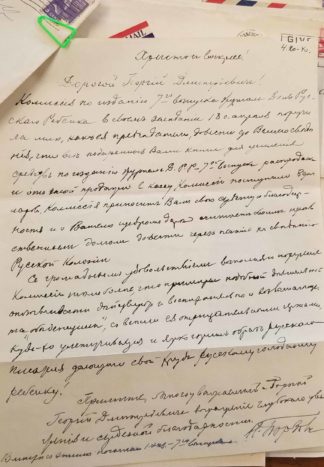
Letter from N.V. Borzov to G.D. Grebenstchikoff, April 20, 1940, courtesy George and Tatiana Grebenstchikoff Papers, IHRCA, Box 14.
Intra-Russian diasporic connections within the United States
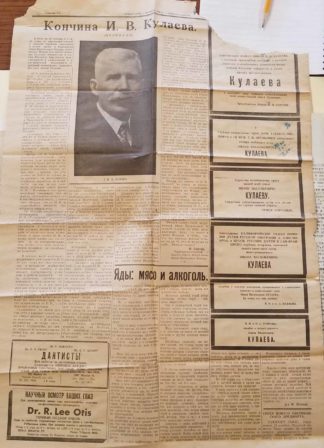
Obituary of Ivan V. Kulaeff, November 25, 1941, Novaya Zarya newspaper, courtesy George and Tatiana Grebenstchikoff Papers, IHRCA, Box 26.
The Russian diasporic community in San Francisco in the 1920s and 1930s immigrated to the United States largely via the Far East with many members of that community native to the region of the Russian Empire east of the Volga River. A contingent lived in China prior to the Russian Revolution, particularly in the city of Harbin.
Intra-Russian diasporic connections and relationships thus developed in a specific pattern due to common Siberian or other specific regional roots, residency in China either pre- or post-Revolution, and subsequent emigration experiences to the West Coast of the United States. Nikolay V. Borzov — active in both educational and philanthropic activities in San Francisco’s Russian community — also administered the Kulaeff Fund, established by a wealthy Siberian industrialist, Ivan V. Kulaeff, to assist Russian émigré educational and philanthropic organizations in their work abroad in the interwar period.
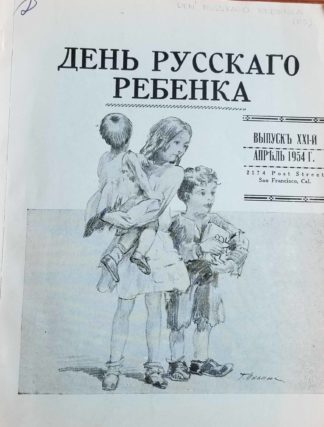
Cover of 1954 issue of Day of the Russian Child journal, published in San Francisco, courtesy IHRCA.
Borzov lived and worked as an educator in Harbin from 1905, bringing his family to Berkeley, California in the 1920s. Kulaeff was a native of Krasnoyarsk in Siberia, resided in China after leaving Russia with his family, and eventually settled in Hollywood, California, providing his children with a higher education at the University of California at Berkeley.
The IHRCA holds the George and Tatiana Grebenstchikoff Papers, which include the Grebenstchikoffs’ correspondence with Borzov and Kulaeff, as well as with many other members of the San Francisco Russian community.
The Grebenstchikoffs lived in Connecticut and Florida but had strong connections to San Francisco, in part due to George’s literary contributions to an annual journal published by Borzov, Den’ Russkovo Rebenka [Day of the Russian Child], the proceeds from the sale of which benefitted impoverished Russian children in emigration.
George Grebenstchikoff was also born in Siberia in a village in the Altai Mountain region, left Russia in 1920, and was very well-known in the worldwide émigré community for his exceptional literary achievements, notably the novel Churaevy.
The class and social status of Borzov, Kulaeff, and Grebenstchikoff speak to a certain aspect of the Russian diaspora in the United States greatly informing my study, specifically: a significant number of émigrés, particularly but not exclusively in San Francisco, were of middle-class status or equivalent, and often achieved such status and consequent economic stability in Russia through their own efforts rather than through family ties or hereditary social rank. The subsequent social activism that émigrés such as Borzov, Kulaeff and Grebenstchikoff exhibited in exile also did much to shape the formation of the Russian diasporic communities with which they interacted.
Materials available at IHRCA also reflect the continuing efforts of the San Francisco Russian community, both in the interwar and post-World War II years, to maintain and support Russian cultural creative effort outside of the Soviet Union while also working to alleviate the extreme economic impoverishment of the most vulnerable members of the Russian diaspora all over the world: children and disabled veterans.
The role of Russian émigré publications
Russian émigré publications were numerous, though many were short-lived due to the straitened economic circumstances of individuals and groups involved in publication efforts. The Immigration and Refugee Services of America Records as well as individual publications at IHRCA, contribute to understanding how various groups within the Russian diaspora maintained cohesion and unity in the face of overwhelming pressure to assimilate into American culture, something Russian émigrés generally resisted as they feared “de-nationalization.”
The range of publications at IHRCA also helps to highlight both continuity and change in the perspective of the San Francisco Russian community with respect to, among other things, political outlook. The post-World War II incoming refugees, consisting, among others, of Displaced Persons from Europe and a large group of approximately 5,000 refugees from Shanghai who lived in camps in Tubabao, the Philippines, for up to three years prior to being allowed entry into the United States. These refugees displayed a more publicly militant anti-Soviet stance than the previous wave of émigrés, who were generally anti-Bolshevik but also hopeful that the Soviet government would either fall or dissolve in the interwar period, allowing a return to their homeland.
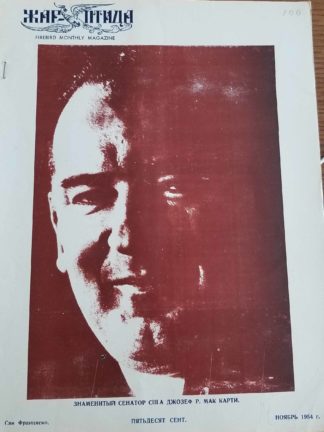
Cover of November 1954 issue of Zha-Ptitsa [The Firebird], published in San Francisco, courtesy IHRCA
The rifts in the community somewhat mirrored rifts in American society in that period as a whole. In the latter, McCarthyist forces targeted Americans who held sympathetic views towards Communism or who had been Communist Party members during Depression-era America, when the collapse of the U.S. economy seemed to be a harbinger of the collapse of capitalism as a viable economic system.
In San Francisco’s Russian diasporic community, more hardline émigrés clashed with those who had, for example, set aside anti-Soviet feeling during the War, when defeating Nazi Germany and the Axis powers was the paramount concern for the United States and its Allies, which included the Soviet Union. The editors of a San Francisco monthly journal, Zhar-Ptitsa [The Firebird], who generally published literary contributions, placed Joseph McCarthy’s image on the cover of the November 1954 issue, making a clear political statement, and included a laudatory article about his anti-communist efforts. Such a blunt articulation of political belief through imagery symbolized both the new virulence of the post-World War II Russian émigrés and the desire to definitively illustrate the sharp divide between the Russian émigré community and Soviet Russia in public discourse.
The pre-World War II diasporic community had, in contrast, avoided such emphatic and public politicized statements, preferring to focus on the rich history and culture of pre-Revolutionary Russia in public displays such as pageants or parades, due in part to feelings of insecurity regarding their tenuous position in an as yet unfamiliar society and culture, as well as to avoid open conflicts and confrontation with, for example, Russian workers’ groups in San Francisco who supported the Bolshevik Revolution in the 1920s.
Conclusion
The materials at IHRCA relating to the San Francisco Russian community and to the diaspora as a whole are invaluable to my study of the inter-relationships of that community and the evolution of its identity against the background of American political culture. I would like to thank the IHRCA for the Grant-in-Aid award that made my travel to the archive possible and for the wonderful assistance of archival staff.


